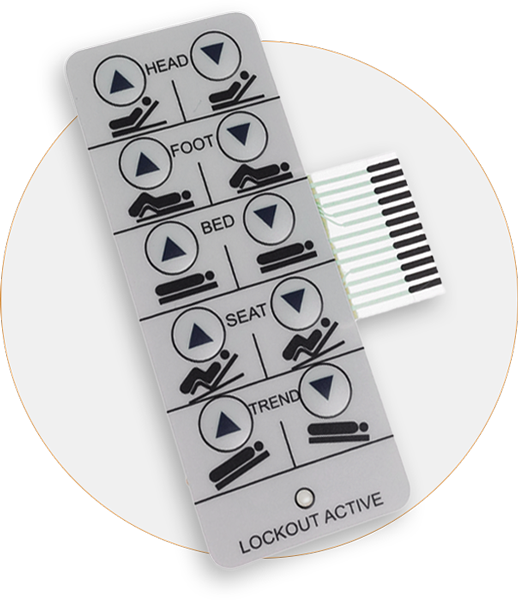Exactly How Membrane Switches Contribute to the Toughness of Electronic Control Panels
Membrane buttons play a crucial role in boosting the toughness of electronic control board, mostly with their multi-layered building which provides reliable defense against environmental elements such as wetness and dust. This design not only reduces the threat of circuit damages and rust however also promotes ease of upkeep due to its smooth surface. The absence of relocating components significantly decreases the possibility of mechanical failings, making membrane switches ideal for demanding applications. The effects of these attributes prolong past mere security, increasing concerns concerning their broader effect on functionality and user experience.
Meaning of Membrane Layer Switches

Membrane buttons are created to be slim and light-weight, making them ideal for applications where space is limited. They can be manufactured in various forms, dimensions, and shades, supplying adaptability in style that fulfills aesthetic and functional needs. Furthermore, membrane switches can incorporate different innovations, such as tactile feedback and LED indicators, boosting individual experience.
Because of their construction, membrane layer buttons are often resistant to dirt, dampness, and general wear, adding to their longevity sought after settings. Their smooth style not only assists in easy cleaning but likewise reduces the threat of mechanical failure, making them a favored selection for producers seeking trusted user interfaces in their digital control panels.
Protection Against Ecological Factors
The design of membrane switches naturally provides a level of protection against different ecological elements, which is crucial for maintaining performance in tough conditions - Membrane Switch. These buttons are commonly created with layers of versatile materials that secure inner components from wetness, dust, and contaminants. By enveloping the circuitry, membrane layer switches over lessen the danger of brief circuits and deterioration, which can significantly hinder efficiency
In addition, the use of robust adhesives and sealants throughout manufacturing enhances their resistance to ecological challenges. Membrane layer buttons can endure direct exposure to chemicals and solvents, making them suitable for sectors such as food handling and health care, where hygiene and tidiness are paramount. Their smooth surface area design likewise stops the accumulation of dust and germs, facilitating simpler cleaning and upkeep.
Temperature level variations are another ecological worry, and membrane buttons are crafted to function efficiently throughout a large variety of temperature levels (Membrane Switch). This flexibility ensures that control panels continue to be operational in numerous setups, from industrial atmospheres to customer electronic devices
Influence On User Interaction
Individual interaction with digital control board is substantially affected by the style and capability of membrane layer switches. These switches give a tactile user interface that boosts the total user experience, enabling intuitive navigating and control. Their receptive nature makes certain that users obtain instant feedback upon activation, which is important for tasks calling for precision and efficiency.
In addition, the smooth surface of membrane layer changes promotes easy cleaning and upkeep, advertising customer self-confidence in the integrity of the interface. This cleanliness is particularly vital in atmospheres where health is paramount, such as medical or food processing settings. Furthermore, the small and light-weight design of membrane layer switches over contributes to the aesthetic allure of control panels, motivating individual involvement via a modern and streamlined look.
Furthermore, the integration of visual elements, such as Bonuses published icons and backlighting, helps users promptly determine features, decreasing the learning contour connected with new devices. As a result, individuals can operate devices better, causing enhanced efficiency and fulfillment. In recap, membrane buttons play a critical role in boosting user communication by combining functionality, looks, and ease of use, ultimately causing enhanced operational efficiency.
Layout Flexibility and Personalization
Style flexibility and personalization are vital elements of membrane layer switches, allowing suppliers to tailor electronic control board to details check my site applications and user needs. This versatility permits for the integration of different design elements, such as shades, graphics, and textures, which can boost the visual charm and customer interaction of the control panel.
Membrane layer buttons can be customized in shapes and size, accommodating a variety of gadgets and applications, from industrial equipment to consumer electronics. This flexibility makes certain that makers can develop instinctive interfaces that straighten with customer expectations and operational requirements. Additionally, the capacity to include special Continued functions such as backlighting or responsive feedback further boosts use, permitting a more interactive experience.
Moreover, the production process for membrane switches supports the rapid prototyping of designs, allowing suppliers to iterate and fine-tune their principles quickly. This ability not only increases the advancement timeline yet additionally ensures that the end product satisfies particular practical and visual standards.

Cost-Effectiveness and Durability
Cost-effectiveness and durability are considerable advantages of membrane buttons, making them an appealing choice for producers and end-users alike. These buttons are typically more economical to produce than standard mechanical switches, largely as a result of their simplified production processes and the minimized number of parts required. This cost benefit prolongs not just to first production however also to long-lasting functional expenditures, as membrane layer switches commonly call for less maintenance and have a lower failure price.
Moreover, the durability of membrane switches contributes to their total worth. Constructed from resilient materials, they are resistant to environmental elements such as wetness, dust, and chemicals, which can result in early wear in other switch types. The absence of moving parts decreases mechanical failure, allowing membrane changes to preserve functionality over prolonged periods.
This durability is especially valuable in applications needing consistent efficiency under demanding problems, such as medical tools and commercial tools. Ultimately, the mix of cost-effectiveness and longevity makes membrane changes an economically feasible option for manufacturers, supplying trusted options that hold up against the examination of time while optimizing financial considerations.
Verdict
In conclusion, membrane switches considerably boost the toughness of digital control panels through their durable building and safety features - Membrane Switch. In general, membrane switches over stand for a trusted and economical selection for enhancing the durability and performance of digital control systems.